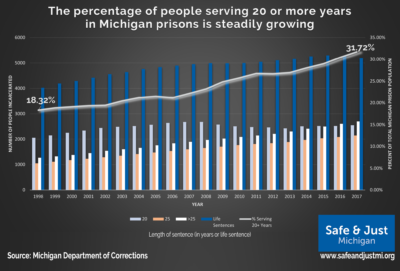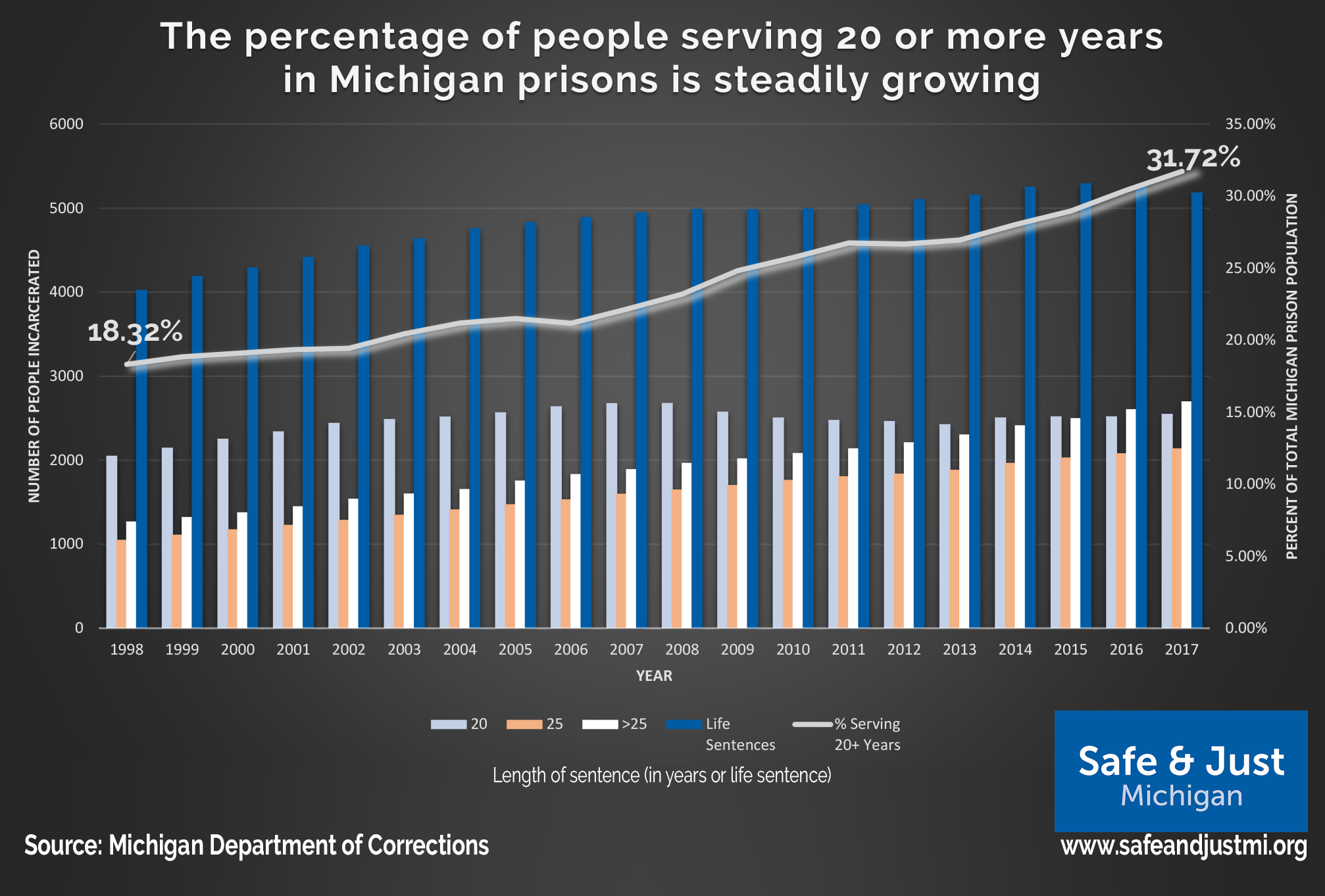Michigan has seen its prison population fall 23 percent since 2006, when we recorded the largest number of incarcerated people in our state at 51,515. That’s the good news.
However, this decline has been offset by a steady increase in the length of stay. Michigan’s prison system has one of the longest average prison sentences in the nation. By the Michigan Department of Corrections’ accounting, the average minimum sentence in Michigan’s prison system is 10.3 years – a figure that does not include the 5,188 people, or 13.1 percent of the total prison population, who were serving life sentences. Since MDOC reports the average minimum sentence, and life sentences do not have a minimum, it does not include lifers in its average minimum sentence calculation.
MDOC does not report how long people actually serve, but a few studies have attempted to quantify this number and track its growth. In 2012, the Pew Center on the States published a report finding that in 2009:
- Michigan had the longest average length of stay of 35 states studied.
- Overall, Michigan prisoners served nearly 17 months more than the average.
- Those serving sentences for assaultive crimes served 30 months longer than the national average.
- Michigan’s 20-year rate of increase in length of stay far exceeded the growth rate of other states.
Similarly, in 2017 the Urban Institute reported that Michigan prisoners had among the longest time served by a couple of different measures:
- Nearly 1 in 4 people in Michigan’s prisons had served 10 years or more; and
- The average time served in the top 10 percent in Michigan was 26 years — a figure that had increased from 10 years in 1989.
Further, it is clear from MDOC data that the number of people serving sentences of 20 or more years — including life sentences — has grown at an alarming rate over the past 20 years. In raw numbers, that number has grown from 8,406 people in 1998 to 12,584 people in 2017. Back in 1998, 18.3 percent of people incarcerated in Michigan prisons were serving these long sentences. In 2017, they comprised 31.7 percent of the prison population.
Some of those people are parolable lifers, meaning that they could eventually be released from prison. In order to do so, they have to meet with approval from the parole board and undergo a psychological report and public hearing. Others are considered “lifers without parole,” which means they can only be released through the action of a governor.
In 2017, 7,396 people, or 18.6 percent, incarcerated in prison were there on sentences of 20 to more than 25 years but less than life. These are people who will eventually be paroled or released.

Why should people care about this?
For one, having so many people serving long-term sentences means that at some point, it will become difficult to drive the overall prison population lower. Even if we continue to reduce the number of people serving short sentences of one to three years, the number of people serving long sentences of 20 years or more will continue to pile up and will not only limit, but ultimately reverse, the population declines.
In turn, that means that Michigan’s correction budget will remain a massive part of Michigan’s budget. The Michigan Department of Corrections already accounts for about $2 billion of Michigan’s budget annually. At an average cost of about $36,000 a year to confine and care for every incarcerated person, it is costing Michigan taxpayers about $456 million annually just to incarcerate people sentenced to 20 or more years in prison. And that cost is only going to grow as that population increases, ages and encounters more health needs.
But perhaps most importantly, there’s no indication that long sentences make us safer. Even top officials at the Michigan Department of Corrections say that. Speaking before a meeting of the Michigan House of Representatives’ Appropriations Subcommittee on Corrections on Feb. 6, 2019, Michigan Department of Corrections Legislative Liaison Kyle Kaminski said:
You can’t just lock up your problems forever. Oftentimes, people think that just sending people to prison for longer will produce better outcomes. There is no research that supports that. In fact, all the research directly disproves that. There is an incapacitation factor — if you are in prison, you can’t cause harm in the community. But once that person comes out after two years or five years, their recidivism rate is no different. So, having them in prison those extra years doesn’t impact their recidivism rate. What does is, what did they do during that time they were in prison?
As Michigan legislators consider prison reform legislation and prepare to set our state’s budget for the coming year, they will have to make wise choices about how to best use taxpayer dollars. Is it smarter to double down on criminal penalties carrying prison sentences of 20 or more years, resulting in a growing number of people serving decades in our prison? Or is it wiser to invest in prison education and job training so that when people who are incarcerated return home, they have the best chance at finding good jobs and supporting their families.
Kaminski said Michigan’s Legislature has recently favored improving programming in our prisons, and he hopes that trend continues.
We at Safe & Just Michigan could not agree more.

